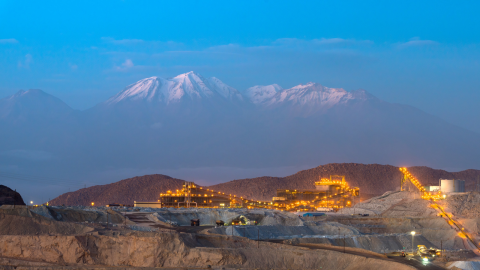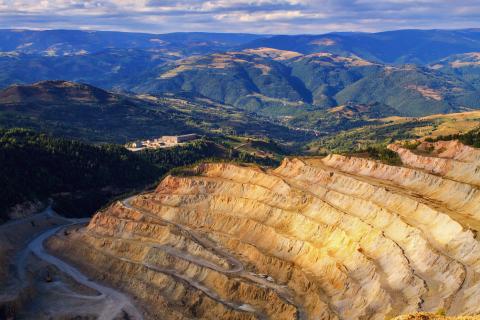
Why critical minerals governance matters in the transition to “net zero”
Leveraging transparency and dialogue to address governance risks for critical minerals
The mining sector is critical to the transition to a low-carbon economy. Solar panels, wind turbines and electric vehicles all rely heavily on minerals such as cobalt, copper, lithium, nickel and others. According to the International Energy Agency, limiting global warming to below 2°C could require a fourfold increase in the supply of minerals for clean energy technologies within the next two decades.
While growing minerals demand could offer economic opportunities – with prospects for investment, revenues and jobs – past mining booms provide a cautionary tale. Failure to tackle governance challenges head on could make the energy transition a curse rather than a blessing for many producing countries. Without transparency and dialogue, demand for minerals could drive economic instability, corruption and environmental and social harm, and could derail global efforts to fight climate change.
Failure to tackle governance challenges head on could make the energy transition a curse rather than a blessing for many producing countries.
The EITI’s latest policy brief sets out how countries rich in minerals can strengthen the sector’s governance and deliver an energy transition that leaves no one behind. It highlights four key risks that could accompany a critical minerals boom, and how disclosures and dialogue can help to address them.
1. Volatile prices could harm public finances and drive political instability
The mining sector has always experienced fluctuations in supply and demand. Mineral volatility could become more extreme during the global energy transition. A handful of countries dominate production of some critical minerals, rendering supply chains vulnerable. Restrictive trade policies or conflicts could drive sudden price spikes. At the same time, technological innovations, mineral substitutions and improved recycling rates could unexpectedly reduce demand for specific minerals. All this makes it hard for governments to anticipate how much money they will earn from the sector, potentially undermining their ability to fund public services and fuelling political instability.
EITI reporting on key aspects of the sector – such as exploration, production and revenues – can shed light on the sector’s economic potential and inform planning on how to allocate revenues in a manner that supports long-term development objectives.
2. An investment drive could increase corruption risks
Many critical minerals deposits are in countries with poor track records on corruption. Over USD 1 trillion in mining investments could be needed by 2035 to ramp up the supply of just five metals – aluminium, cobalt, copper, lithium and nickel. The business opportunities associated with this investment drive – including the awards of mining rights, procurement contracts and commodity trading deals – could be vulnerable to corruption.
Disclosing contracts and beneficial owners in line with the EITI Standard can be a powerful antidote. Contract transparency enables agreements to be compared, and incentivises government officials to arrange fair deals with reputable companies in a way that is consistent with the country’s legal framework and industry norms. It also deters officials from concluding contracts that are disadvantageous or result in personal gain. Furthermore, beneficial ownership information can help anti-corruption actors identify whether mining licenses and contracts have been awarded to politically-connected companies.
3. High prices could push mining into more environmentally and socially sensitive areas
Many critical minerals deposits are in environmentally and socially sensitive areas. Water, land, biodiversity and indigenous rights are likely to become increasingly pressing issues around many of the world’s mines. For some minerals, a mining boom could encourage production from artisanal and small-scale mining, a sector associated with a distinct set of challenges. Meanwhile, attempts to sidestep community issues could see a push for seabed mining, a potentially controversial method. All of this means that the energy transition’s minerals demand could harm communities and damage the environment.
Reporting on environmental monitoring and payments can support responsible business practices by shedding light on the performance of mining companies. The EITI’s multi-stakeholder platform is also an important medium for inclusive dialogue on how to address risks associated with informal or unconventional mining, especially for communities that are most affected by mining operations.
4. Demands for state participation could exacerbate governance challenges
Perceptions around the strategic and economic importance of critical minerals are already prompting many governments to seek greater control over the mining sector. State-owned companies may seek to secure larger ownership stakes in mining projects and governments may impose more stringent requirements related to domestic processing and local content. Without adequate safeguards, state participation can become a strain on public finances and can be vulnerable to corruption. Large deals with commodity traders can also present governance risks and exacerbate sovereign debt in times of volatility if terms are not properly negotiated. The EITI’s requirements on transparency related to state participation can help to promote public oversight of state-owned enterprises to ensure their operations are aligned with the public interest.
The time is now to strengthen mining sector governance.
The global shift to net-zero has the potential to provide benefits to the countries producing the minerals used in low-carbon technologies. To ensure this happens, strengthening transparency and multi-stakeholder dialogue is more important than ever. The time is now to strengthen mining sector governance.
Strengthening governance of critical minerals
This policy brief explains how EITI implementation can help to address governance risks for the critical minerals sector in producing countries.
Related content


Why transparency matters for critical mineral supply chains



